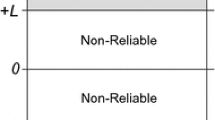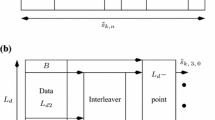Abstract
This paper investigates the tradeoffs of source coding, channel coding and spreading in CDMA systems. We consider a system consisting of an image source coder, a convolutional channel coder, an interleaver, and a direct sequence spreading module. With different allocations of bandwidth to source coding, channel coding and spreading, the system is analyzed over a frequency selective Rayleigh fading channel. The performance of the system is evaluated using the cumulative distribution function of peak signal-to-noise ratio. Tradeoffs of different components of the system are determined through simulations. We show that, for a given bandwidth, an optimal allocation of that bandwidth can be found. Tradeoffs among the parameters allow us to tune the system performance to specific requirements.
Similar content being viewed by others
References
B.D. Pettijohn, K. Sayood, and M.W. Hoffman, “Joint Source/Channel Coding Using Arithmetic Codes,” IEEE Proceedings DCC 2000. Data Compression Conference, March 2000, pp. 73-82.
G. Cheung and A. Zakhor, “Bit Allocation for Joint Source/Channel Coding of Scalable Video,” IEEE Transactions on Image Processing, vol. 9,no. 3, 2000, pp. 340-356.
M. Zhao, A.A. Alatan, and A.N. Akansu, “A New Method for Optimal Rate Allocation for Progressive Image Transmission Over Noisy Channels,” Proceedings DCC 2000. IEEE Data Compression Conference, March 2000. pp. 213-222.
D.J. Van Wyk, I.J. Oppermann, and L.P. Linde, “Performance Tradeoff Among Spreading, Coding and Multiple-Antenna Transmit Diversity for High Capacity Space-Time Coded DS/CDMA,” Proceedings of Conference on Military Communications MILCOM 1999, Sept. 1999, vol. 1, pp. 393-397.
I. Oppermann and B. Vucetic, “Capacity of a Coded Direct Sequence Spread Spectrum System Over Fading Satellite Channel Using an Adaptive LMS-MMSE Receiver,” IEICE Trans. Fundamentals, vol. E79-A,no. 12v, 1996, pp. 2043-2049.
J.R. Foerster and L.B. Milstein, “Coding for a Coherent DS-CDMA System Employing an MMSE Receiver in a Rayleigh Fading Channel,” IEEE Transactions on Communication, vol. 48,no. 6, 2000, pp. 1012-1021.
A. Said and W.A. Pearlman, “A New, Fast, and Efficient Image Codec Based on Set Partitioning in Hierarchical Trees,” IEEE Transactions on Circuits and Systems for Video Technology, vol. 6,no. 3, 1996, pp. 243-250.
P.G. Sherwood and K. Zeger, “Progressive Image Coding on Noisy Channels,” IEEE Signal Processing Letters, vol. 4,no. 7, July 1997, pp. 189-191.
J. Hagenauer, “Rate-Compatible Punctured Convolutional Codes (RCPC Codes) and Their Applications,” IEEE Transactions on Communication, vol. 36, April 1988, pp. 389-400.
J.G. Proakis, Digital Communications, New York: McGraw-Hill, 1995.
L.L. Chong, “The Effects of Channel Estimation Error on Wideband CDMA Systems with Path, Frequency, Time, and Space Diversity,” Ph.D. Dissertation, University of California, San Diego, 2001.
W.C. Jakes, Microwave Mobile Communications, Piscataway, NJ: IEEE Press, 1993c 1974.
P. Dent, G.E. Bottomley, and T. Croft, “Jakes' Model Revisited,” Electronics Letters, vol. 29,no. 13, 1993, pp. 1162-1163.
P.C. Cosman, J.K. Rogers, P.G. Sherwood, and K. Zeger, “Combined Forward Error Control and Packetized Zerotree Wavelet Encoding For Transmission of Images Over Varying Channels,” IEEE Transactions on Image Processing, June 2000, pp. 982-993.
Author information
Authors and Affiliations
Rights and permissions
About this article
Cite this article
Zhao, Q., Cosman, P. & Milstein, L.B. Tradeoffs of Source Coding, Channel Coding and Spreading in Frequency Selective Rayleigh Fading Channels. The Journal of VLSI Signal Processing-Systems for Signal, Image, and Video Technology 30, 7–20 (2002). https://doi.org/10.1023/A:1014034506244
Published:
Issue Date:
DOI: https://doi.org/10.1023/A:1014034506244




